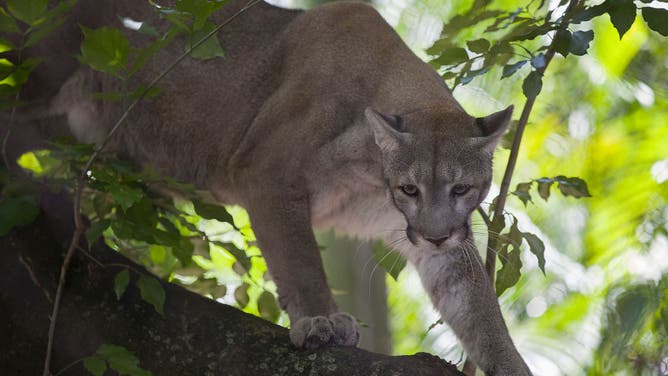Florida panther deaths more than double from previous year
The FWC estimates there are only 120-230 adult panthers alive in South Florida. The population has rebounded from a population of just around two handfuls since the species was put on the Endangered Species List in 1967.
Panthers caught on video strolling in South Florida
A Florida panther and her three offspring walk through the Corkscrew Swamp Sanctuary in Southwest Florida on January 4, 2015. (From the FWC/ Brian Hampton)
NAPLES, Fla. – Florida wildlife experts have reported the 30th panther death of 2024, more than double the total number of fatalities reported just last year.
The Florida Fish and Wildlife Conservation Commission said the latest fatality occurred in Southwest Florida when a 3-year-old cat was struck by a passing vehicle.
Collisions with automobiles accounted for more than three-quarters of all deaths this year and is annually the leading cause of fatalities around the state.
According to data from the FWC, Collier County accounted for the most fatalities, with deaths also reported in Hendry, Glades, Lee and Broward counties.
Biologists estimate there are between 120 and 230 adult panthers in South Florida, with most living south of Lake Okeechobee.
Although the estimated population may seem small, it has significantly rebounded from the 1960s, when fewer than a dozen panthers were believed to be in the wild.
MANATEES MAY BE RECENT ARRIVALS TO FLORIDA, STUDY SUGGESTS
The Florida panther was added to the Endangered Species List in 1967 and was made the state’s official animal in 1982.
Despite increases in the population, scenes of collisions with vehicles serve as a reminder that human activities remain the greatest threat to the species.
The Conservancy of Southwest Florida, a nonprofit organization working to protect the natural environment, has advocated against the construction of developments that would inhibit the carnivore’s natural habitat and increase dangers from vehicles.
The group maintains a sprawling development about 15 miles east of Naples near the critical Florida Panther National Wildlife Refuge would destroy hundreds of acres where the animals constantly roam.
"Loss of these core habitats, fragmentation of an essential corridor, more cars on the road, and impacts to the nearby Panther Refuge will jeopardize the Florida panther’s future," the conservancy previously stated.
The refuge was established in June 1989 to help protect the Florida panther and encompasses nearly 27,000 acres in the southwestern portion of the state.

PALM BEACH, FLORIDA - AUGUST 22: A healthy Florida panther is seen on display at the Palm Beach Zoo on August 22, 2019 in Palm Beach, Florida. The Florida Fish and Wildlife Conservation Commission is investigating an apparent neurological problem that has been seen in wild Florida panthers. The issue has been seen in the endangered panthers as well as bobcats and is causing them to have trouble walking, and wildlife experts don’t know why.
(Photo by Joe Raedle/Getty Images / Getty Images)
BIOLOGISTS RESCUE ENDANGERED SAWFISH IN FLORIDA KEYS AS RACE TO SAVE SPECIES UNDERWAY
State transportation officials recognize the need for additional measures to prevent collisions between the growing human population and wildlife.
The Florida Department of Transportation reports constructing the first wildlife crossings in the early 1990s, with several more in the planning or construction phases in Central and South Florida.
Earlier this year, an extensive wildlife crossing under Interstate 4 opened, with observers spotting animals using the infrastructure within weeks.
The FWC reports that at least 60 wildlife crossings and bridges have been adapted for use by panthers.
"The FWC, FDOT and U.S. Fish and Wildlife Service consider the potential need for new crossings and fencing as new roads are built or as existing roads require added capacity. Including wildlife crossings early in the planning stages for these kind of projects lowers the costs of these safety features," the FWC previously stated.
